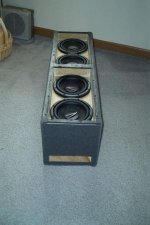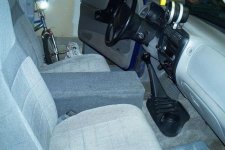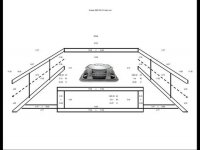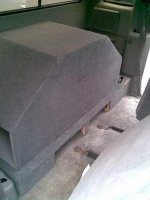The Bose system uses in-line compression... Using lamp compression...
Regarding Brian's insights into the Bose engineering, it's an old trick from the 1950's and I unfondly remember checking 12v car bulbs for expansion (to counter-act vinyl recording compression, eh).
The Bose folks also used what would be deemed at this forum crazy-high crossover at 200 Hz.
With music, you can cross over high like that provided - as the Bose folks realized - the sub speaker wasn't revealing distortion products and the slope was steep (what's the term poker players use?). I've been near 140 Hz since 1968 and never localized a peep from any sub.
As for the OP question, I'd guess the whole problem of power and heat are exaggerated. The "duty cycle" of music is tiny, even if we do need amp and tweeter headroom for female (esp girl) choruses singing Brahms Lullaby (no kidding). Having said that, hard to imagine building a sealed box that didn't leak a bit somewhere for barometric pressure changes and always sensible to drill a little hole just in case it didn't.
B.
Last edited:
Here a sentence found here that best resume a big part of what i would be interested to limit "A loudspeaker with asymmetrical parameters will rectify an AC signal producing a DC-component in the displacement dynamically. "
From this point of view, isobaric loading seems a easy way to go.
From this point of view, isobaric loading seems a easy way to go.
Last edited:
Refound something interesting...in french, so easier for me ! Klippel test study with real speaker https://www.ens-louis-lumiere.fr/sites/default/files/2017-08/Frick_Son_2016.pdf
The chosen solution is split voicecoil use, as some bcspeakers.
They talk about different way to prevent it, and too about stiffer suspension, talking about spider, wich is exactly what does a small closed back but with air as suspension...
The chosen solution is split voicecoil use, as some bcspeakers.
They talk about different way to prevent it, and too about stiffer suspension, talking about spider, wich is exactly what does a small closed back but with air as suspension...
Last edited:
somewhat OT but dealing with dynamic offset for vented boxes. Joh Risch had an interesting patent
US6549637B1 - Loudspeaker with differential flow vent means
- Google Patents
US6549637B1 - Loudspeaker with differential flow vent means
- Google Patents
Last edited:
The Bose folks also used what would be deemed at this forum crazy-high crossover at 200 Hz.
The "80 Hz" subwoofer LP filter thing is based on the use of a 12dB octave filter, and the resulting signal level at 200 Hz. Theoretically, the steeper the filter, the higher you can make the cutoff frequency.
I think Bose did kind of lose the plot a little though with that particular bandpass design. By making the passband so wide, they gave up some of its filtering capabilities. And the satellites are still cut off a bit too high for my tastes. The power limiting speaker protection method that they use works very well however.
which incandescent light bulb makes the most sense performance & money wise for woofers?
here's an image which I bumped into at Pininterest

here's an image which I bumped into at Pininterest

Last edited:
I always design my BP4's where the back of the woofer is always in the vented section of the enclosure.
Attachments
when seeing the thumbnail, thought: "1 person fallout shelter/septic tank"

This family must be French - they stuffed the opening at the right with baguettes! When they are a bit hungry they just reach over and get a fresh one. Awesome.
they can't be french there's no wine cellar....and he's not wearing a barret...il sont foux ces anglais!!
- Status
- Not open for further replies.
- Home
- Loudspeakers
- Subwoofers
- Closed back Vs others enclosures & DC offset (Xmax & voicecoil rest position stabili)




